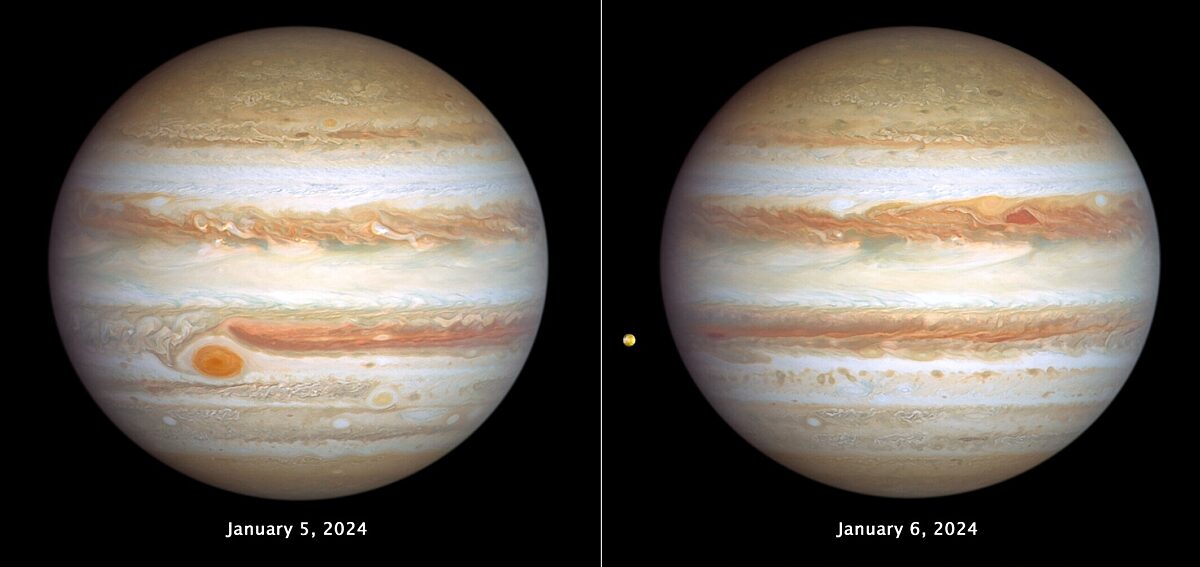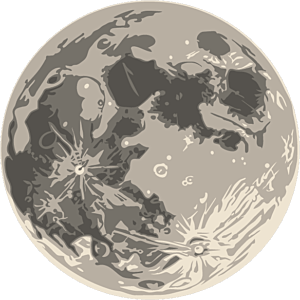The Downlink • Mar 22, 2024
Hidden depths and a cosmic mystery
Space Snapshot

The Hubble Space Telescope captured these two images of Jupiter across two days in January 2024, capturing both sides of the giant planet thanks to its rapid rate of rotation. The images show a large number of storms, giving insight into the overall activity taking place in Jupiter's atmosphere. The moon Io is visible to the left of Jupiter in the Jan. 6 image. Image credit: NASA / ESA / J. DePasquale (STScI) / A. Simon (NASA-GSFC).
Fact Worth Sharing

When we look at Jupiter we see its outermost layer of clouds. Made of ammonia ice, ammonium hydrosulfide crystals, and water ice and vapor, this cloud layer is about 71 kilometers (44 miles) thick. Below, Jupiter’s atmosphere extends for thousands more kilometers or miles.
Mission Briefings


China has launched a new Moon relay satellite. Missions on the far side of the Moon can’t communicate with Earth without a relay satellite. Queqiao-2 launched this week to provide that relay solution for China’s lunar exploration program. The mission’s goals include supporting the upcoming Chang’e-6 lunar farside sample return mission, scheduled to launch in 2024. Pictured: China’s Chang'e-5 spacecraft captured this view of Earth over the far side of the Moon on Oct. 28, 2014. Image credit: CAST.

The DART impact changed asteroid Dimorphos’ shape and orbit. Follow-up observations of the asteroid have found evidence that when the DART (Double Asteroid Redirection Test) mission intentionally smashed into Dimorphos in 2022, it did more than just change its orbit around its parent asteroid, Didymos. Dimorphos appears also to have changed shape, from a relatively symmetrical object to a “triaxial ellipsoid” — something more like an oblong watermelon. Pictured: Dimorphos prior to impact, imaged by DART. Image credit: NASA / Johns Hopkins APL.

Urban micrometeorite hunters are searching rooftops for cosmic dust. Thousands of tons of micrometeorites fall to Earth each year, mostly tiny particles between 50 micrometers to two millimeters in diameter. These fall everywhere, but are more easily found in places that are large, inaccessible, and largely untouched. Antarctica is a good place for micrometeorite hunters, but so are cathedral roofs.

If you dream of being an astronaut, prepare for space headaches. A new study from Leiden University Medical Center in the Netherlands has found that astronauts with no prior history of headaches may experience migraines and tension headaches while spending longer periods (over 10 days) in space. These headaches are likely caused by the vestibular system, which affects balance and posture, trying to adapt to signals it is receiving from the body that conflict with the signals it expects.
From The Planetary Society


Some people go above and beyond in their service to humanity. Dante Lauretta, the principal investigator for NASA's OSIRIS-REx mission, is one of those people. Through decades of hard work and perseverance, he has become a world leader in the effort to understand asteroids, one of the largest existential threats to humanity. Dante joins this week’s Planetary Radio to share stories from his new book, "The Asteroid Hunter." Pictured: Rocks flying off asteroid Bennu after NASA's OSIRIS-REx spacecraft touched the surface to collect a sample on Oct. 20, 2020. Image credit: NASA/Goddard/University of Arizona.

It’s time to brush up on your eclipse knowledge. With the North American total solar eclipse less than a month away, now is a great time to learn everything there is to know about eclipses. We’ve got you covered with our online course all about solar and lunar eclipses, available for free to Planetary Society members. Plus, check out our Chief Scientist Bruce Betts’ new eclipse book for kids, “Casting Shadows.” (If you’ve read the book and loved it, leave a review!)

Be there, do that, get the T-shirt. If you get the chance to witness the April 8, 2024 total solar eclipse, make the memories last with some custom eclipse gear. Our partners at ChopShop have produced an array of eclipse-related clothing, accessories, decor, and more. Every purchase supports The Planetary Society’s mission.
New in the member community


Got questions about space travel? Ask an astronaut. NASA Space Shuttle astronaut Tom Jones will chat with Planetary Society members on March 28 in a live virtual Q&A event. Tom will answer members’ questions and discuss his book “Space Shuttle Stories,” which draws on interviews with over 130 fellow astronauts who participated in all 135 Space Shuttle missions.

ICYMI: Q&A on NASA’s fiscal year 2025 budget. Last week, The Planetary Society’s Chief of Space Policy Casey Dreier and Director of Government Relations Jack Kiraly joined members for a live Q&A about how the 2025 President’s budget request could affect our space programs. Anyone can watch the recording of the event. If you want to join future live Q&As in the member community and aren’t yet a member, join today!
What's Up

Look for Jupiter shining very bright in the evening eastern sky. On March 24, Mercury will be as high in the evening sky as it will get this viewing period. Reddish Mars is low in the predawn east, with Venus and the much dimmer Saturn very low to the eastern horizon. On March 25 there will be a full Moon and, in North and South America, eastern Asia, much of Australia, and much of Africa, there will be a penumbral lunar eclipse where the Moon passes through the outer portion of Earth’s shadow (the penumbra). Find out what else to look for in this month’s night skies.
Wow of the Week

“A dark mystery has settled over the city of Aldastron on the rogue planet of Exlaris. Only an ambitious crew of adventurers can uncover what was lost. Are you up to the challenge?” This may sound like a teaser for any old role-playing game, but this one is special. NASA's Goddard Space Flight Center recently released an original tabletop roleplaying game, "The Lost Universe,” in which players must work together to unravel a cosmic mystery involving the Hubble Space Telescope. The game is free to download. Image credit: NASA Goddard Space Flight Center.
Send us your artwork!
We love to feature space artwork in the Downlink. If you create any kind of space-related art, we invite you to send it to us by replying to any Downlink email or writing to [email protected]. Please let us know in your email if you’re a Planetary Society member!


 Explore Worlds
Explore Worlds Find Life
Find Life Defend Earth
Defend Earth

